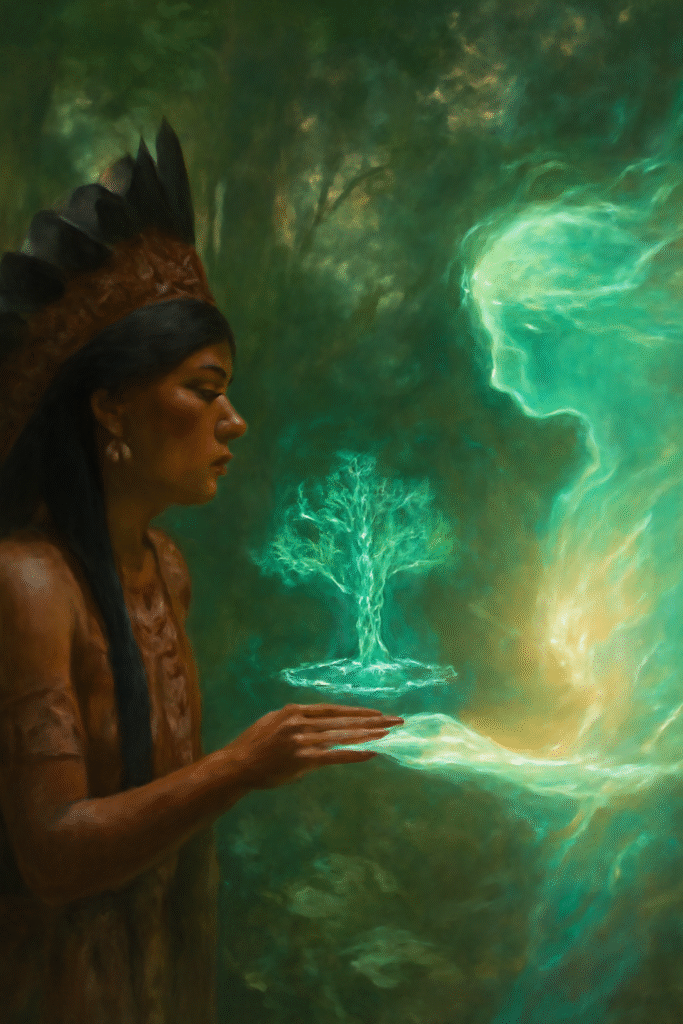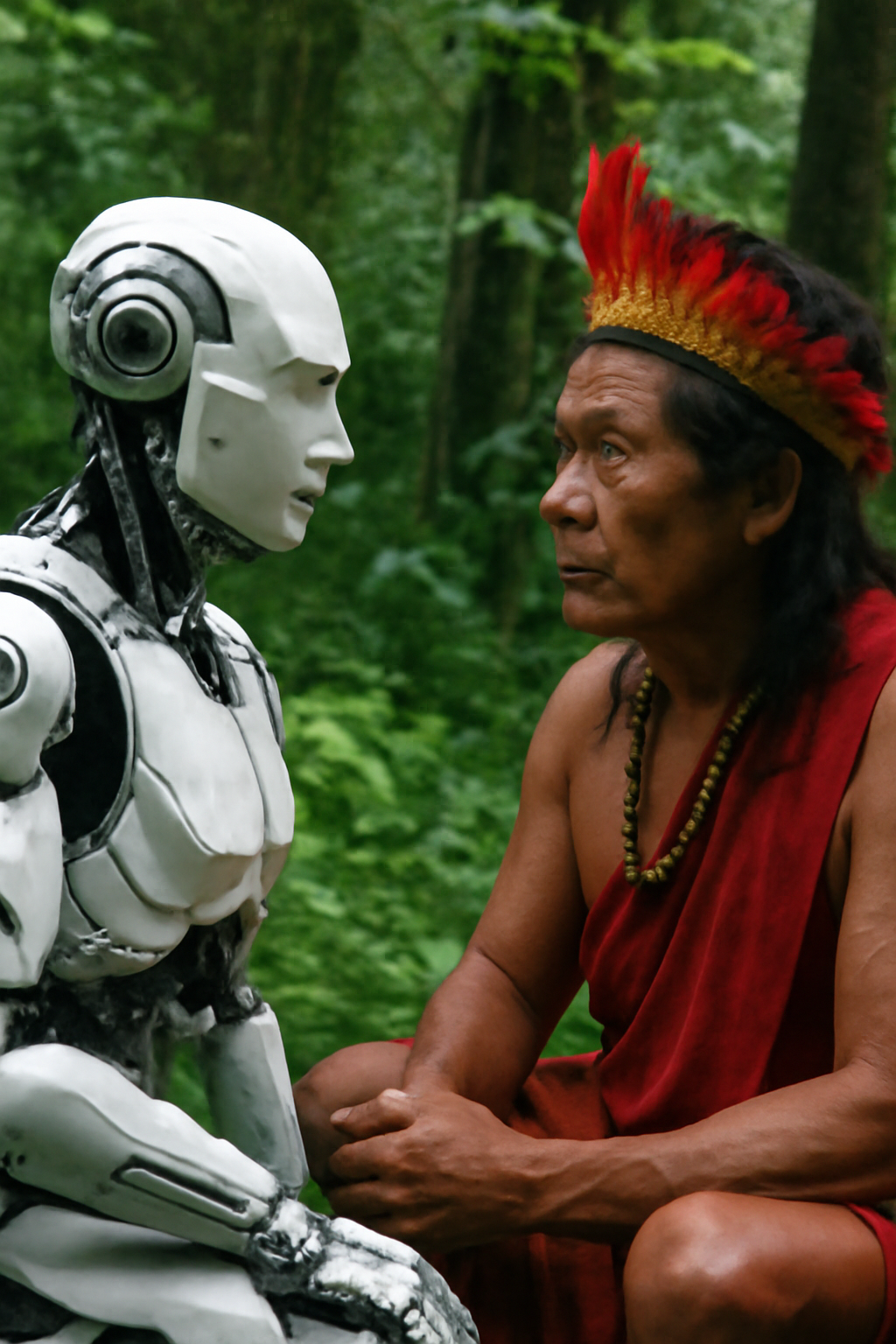Descubra como a inteligência artificial e o conhecimento ancestral dos povos indígenas podem unir forças para proteger o planeta e construir um futuro verdadeiramente sustentável.
A tecnologia está presente no nosso dia a dia, e a maioria de nós já ouviu falar sobre IA — inteligência artificial. No entanto, muito antes da ciência moderna, outro tipo de inteligência já guiava a humanidade: a sabedoria indígena.
O que é fascinante é que esses dois mundos, um digital e outro ancestral, podem realmente trabalhar juntos para proteger a vida na Terra. Vamos explorar como esse diálogo entre tecnologia e tradição pode ajudar a curar e proteger o nosso planeta.
O que é Inteligência Artificial?

A inteligência artificial é um ramo da tecnologia projetado para tornar máquinas e softwares capazes de aprender, raciocinar e tomar decisões — quase como se pudessem pensar.
Vemos isso em ação em todos os lugares: corrigindo a nossa escrita, reconhecendo fotos, sugerindo músicas, respondendo perguntas e até mesmo ajudando carros a se conduzirem sozinhos.
Cientistas e engenheiros passam anos aperfeiçoando esses sistemas para poderem ajudar as pessoas de forma mais eficaz.
Mas, para usar a IA com sabedoria, precisamos fazer perguntas mais profundas: como essa tecnologia pode melhorar a vida de todos os seres vivos? E como ela pode servir ao planeta em vez de explorá-lo?
Quem são os povos indígenas e qual é a sua sabedoria?
Os povos indígenas são os habitantes originais de muitas regiões ao redor do mundo. Só no Brasil, existem centenas de nações indígenas, cada uma com sua própria língua, histórias e formas únicas de ver o mundo.
A sua sabedoria é construída com base na observação, no respeito e na coexistência com a natureza. Eles sabem como colher da terra sem a esgotar, quais plantas podem curar e como todas as espécies — humanos, animais, rios e árvores — compartilham um equilíbrio sagrado.
Esse conhecimento ancestral, preservado ao longo de gerações, mostra que viver bem não é tirar mais, mas cuidar — garantindo que a vida continue para aqueles que virão após nós.
O que significa realmente sustentabilidade?
Sustentabilidade é a arte de usar o que a Terra oferece hoje sem roubar do amanhã.
Significa proteger a água, o solo, os animais e as florestas para que as gerações futuras também possam prosperar.
Viver de forma sustentável é reduzir o desperdício, respeitar os ciclos naturais e compreender que o bem-estar humano e a saúde ecológica estão eternamente ligados.
Como a IA pode proteger a natureza
Quando orientada por intenções éticas, a IA pode tornar-se uma poderosa aliada do ambiente.
Aqui estão algumas maneiras pelas quais ela já está a ajudar.
Como a sabedoria indígena ensina a sustentabilidade
Enquanto a IA olha para o futuro através dos dados, a sabedoria indígena olha para o presente através das relações.
Para as comunidades indígenas, a natureza não é um recurso, é um parente.
A terra, a água, os animais e as pessoas pertencem a uma rede viva.
Os seus ensinamentos lembram-nos que a sustentabilidade não é apenas um processo técnico, mas também moral e espiritual:
plantar sem prejudicar,
caçar sem exterminar,
colher sem destruir.
Essa abordagem ancestral reflete séculos de observação cuidadosa e respeito — lições que a civilização moderna precisa urgentemente relembrar.
IA e sabedoria indígena: juntos pela natureza

Agora imagine essas duas fontes de inteligência — uma digital, outra ancestral — trabalhando em uníssono.
Essa visão já está a tornar-se realidade em vários projetos ao redor do mundo.
Proteção territorial
Comunidades indígenas estão a usar drones, sensores e ferramentas de IA para monitorizar as suas terras, detectando extração ilegal de madeira, incêndios e invasões antes que causem danos.
Preservação do conhecimento curativo
Os sistemas de inteligência artificial ajudam a registar e organizar remédios tradicionais à base de plantas, garantindo que esse conhecimento seja transmitido às gerações mais jovens sem se perder.
Mapeamento de rios e vida selvagem
Usando IA, pesquisadores e guardiões indígenas podem rastrear rios, identificar espécies ameaçadas de extinção e combinar a observação tradicional com o mapeamento digital para um cuidado ambiental proativo.
Projetos educacionais
Jogos e aplicativos educacionais baseados em IA ensinam crianças indígenas e não indígenas sobre o respeito à natureza, combinando diversão e responsabilidade ambiental.
Por que esta aliança é importante?

O planeta está sob enorme pressão — o desmatamento, a poluição e a instabilidade climática estão a intensificar-se.
A tecnologia pode ajudar, mas por si só carece de empatia e sabedoria.
Quando a inteligência artificial aprende com a filosofia indígena — que valoriza o equilíbrio, a reciprocidade e a gratidão para com a natureza — começamos a moldar a inovação que honra a vida em vez de dominá-la.
Os povos indígenas protegem a terra com reverência.
A IA oferece ferramentas para defendê-la e regenerá-la.
Juntos, eles representam uma bela parceria entre sistemas de conhecimento — a tradição preservando o significado e a tecnologia amplificando a ação.
O futuro: conexão através da sustentabilidade
Um mundo sustentável depende da cooperação.
A IA aprende com dados, padrões e métricas.
A sabedoria indígena aprende com o silêncio, a observação e a narrativa.
Se essas perspectivas se ensinarem mutuamente, a humanidade poderá crescer tanto tecnologicamente quanto espiritualmente.
Crianças, estudantes e futuros cientistas podem aprender que tecnologia e tradição não são opostas — elas são aliadas.
Quando combinadas com respeito, estas duas inteligências formam o diálogo ecológico de que a Terra tanto precisa.
